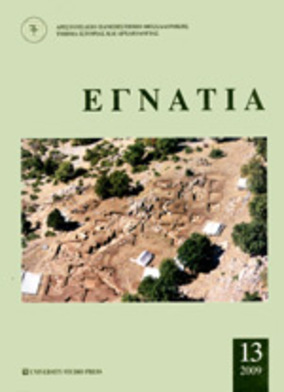Χάλκινο παιδικό πορτρέτο από τους Φιλίππους
Part of : Εγνατία ; No.10, 2006, pages 145-161
Issue:
Pages:
145-161
Parallel Title:
Bronze head of a child from Filippoi (Macedonia)
Section Title:
Μελέτες
Author:
Abstract:
The article deals with the bronze head of a child from the new excavation of the University of Thessaloniki at Filippoi. The sculpture was found in 1997 in an insula with many mosaic floors from its first phase. Only the face with a small part of the front of the head and the front part of the neck is saved. The markings on the inner and the outer surfaces lead to the conclusion that it was crafted by the indirect lost-wax casting technique. The state of preservation of the object and the fact that it was found near a big kiln belonging to the second phase of the building lead to the conclusion that it cannot have been found near its original place. It seems that it was destroyed so that the melted bronze would be re-used. It is possible though that the sculpture was already damaged, probably by an earthquake.The head represents a child of 2-4 years of age. It is compared to its technical features, the style and the hair-style with a bronze portrait of a youth from Cyprus (±160 AD.), a portrait of Polydeukion (148-178 AD.), as well as with a portrait of young Commodus at the age of 5. Consequently, the portrait can be dated to the third quarter of the 2nd century A.D. and maybe between 160 and 170 A.D.A special feature of the figure is the jewel in the middle of the head. Jewels of that kind are common on representations of children, from all-over the empire, but also on representations of the Matronae, some divinities from the West who watched over children, and on funerary portraits of adults from the East. It is believed that it connected the child who wore it with deities, who protected it while alive as well as after death. These deities sometimes received mystic cult but the jewel does not characterize the child as a member of such a cult. It is possible that it originates from a plait worn by many children, which was often reserved for dedication to one of the divinities who watched over children. This plait and consequently the jewel were connected with ancient Greek rites of transition. Finally, it seems that this jewel was quite common in the area of Macedonia because quite a few portraits of children were found here, as well as a jewel in the tomb in the Oktagon at Filippi.The portrait from Filippoi could have been a grave portrait or a votive offering but it could also have been exposed in a house. We cannot say where it was created because bronze portraits are not very common. But we can say for sure that the portrait we found is a work of art from the time of the Antonines and it shows that the city of Filippoi was a flourishing city at that time.
Subject:
Subject (LC):
Notes:
Για την άδεια δημοσίευσης του αντικειμένου θα ήθελε να ευχαριστήσει τον διευθυντή της ανασκαφής καθηγ. Βυζαντινής Αρχαιολογίας Γ. Γούναρη. Επίσης, για τις συμβουλές και τις συζητήσεις καθώς και για τον χρόνο που αφιέρωσε στην ανάγνωση του κειμένου θα ήθελε να ευχαριστήσει την καθηγ. Κλασικής Αρχαιολογίας Θ. Στεφανίδου-Τιβερίου., Περιέχει εικόνες και κατόψεις




